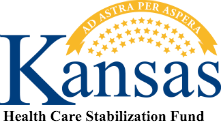About
History of the Health Care Provider Insurance Availability Act
The 1976 Legislature enacted the original version of the Health Care Provider Insurance Availability Act. Among other things, the Availability Act created the Health Care Stabilization Fund (HCSF). The Availability Act requires that all health care providers, as defined in the Act, purchase professional liability insurance and participate in funding the HCSF by paying a surcharge on their premiums for professional liability coverage. The Legislature decided to make liability insurance a condition of active licensure in Kansas. To accommodate those doctors who could not buy commercial insurance coverage, a joint underwriting association was created; the Health Care Provider Insurance Availability Plan.
An important feature of the early version of the Availability Act was a requirement that insurance policies provide “claims made” coverage in lieu of occurrence coverage. This was accompanied by a somewhat unique provision for prior acts coverage under the HCSF. In other words, the health care provider is insured for any claims made during the term of the insurance policy. Equally important, if the doctor retires or leaves Kansas to practice elsewhere, he or she receives coverage via the HCSF for any claims that may arise after his or her liability insurance policy is discontinued and he or she discontinued their Kansas practice. Similarly, if a health care provider facility discontinues operations and discontinues its liability insurance policy, the HCSF provides continued coverage for claims that may arise as a result of patient care provided before the facility was closed.
In 1984 the Legislature enacted a number of significant amendments to the original Availability Act. Among other things, there was a limit imposed on the amount that could be recovered from the HCSF. That year, the Legislature also established a Board of Governors to advise the Commissioner of Insurance. Another major amendment removed the statutory limit on the Fund’s balance and prescribed that premium surcharges should be based on estimated accrued liabilities. In other words, the Legislature decided the HCSF should be actuarially balanced.
During the second half of the eighties decade there was continued pressure on the Legislature to reform the rules of civil litigation. The controversy surrounding tort reform focused a great deal of attention on the HCSF. Some legislators insisted that the State should divest from the HCSF and legislation was passed that provided for a gradual phase-out of the Stabilization Fund.
The filing of new cases began to level off during the early nineties, and the Fund assets gradually increased. By 1992 the HCSF was considered actuarially balanced, and premium surcharges were reduced accordingly. By this time, interest in phasing out the HCSF had waned. Instead, the 1994 Legislature decided to remove the HCSF from the Insurance Department. On July 1, 1995 the HCSF was made independent, and the Board of Governors appointed an Executive Director. The Commissioner of Insurance retains an important role, however. Members of the Board of Governors are appointed by the Commissioner.
The Kansas Health Care Provider Insurance Availability Act has accomplished legislative intent. It provides stability by assuring that physicians and other health care professionals have access to liability insurance, it promotes a stable market environment for the commercial insurance companies, and it provides for efficient administration of the Health Care Stabilization Fund.
The HCSF is currently governed by a Board consisting of five physicians, three representatives of Kansas hospitals, one representative of Kansas adult care facilities, one chiropractor, and one nurse anesthetist. The day to day operations are managed by an Executive Director.
Health care providers are required to purchase professional liability insurance from commercial companies or from the Availability Plan. The insurance policy must provide minimum coverage limits of $200,000 per claim with an annual aggregate total limit of $600,000 coverage. The health care providers are also required to select one of three options for additional coverage via the HCSF. Those options are: $100,000 per claim with $300,000 annual aggregate, $300,000 per claim with $900,000 annual aggregate, or $800,000 per claim with $2,400,000 annual aggregate.
As of January 1, 2015 there are twenty one categories of health care providers required by law to participate in the HCSF: (1) three types of medical care facilities – hospitals, ambulatory surgery centers, and recuperation centers, (2) three types of adult care facilities – nursing facilities, assisted living facilities, and residential health care facilities, (3) the three licensees under the Healing Arts Act; D.C.s, D.O.s, and M.D.s, (4) podiatrists, (5) nurse anesthetists, (6) nurse midwives, (7) physician assistants, (8) professional corporations, (9) limited liability companies, (10) partnerships, (11) not-for-profit corporations, (12) graduate medical education programs affiliated with the University of Kansas, (13) dentists certified by the Board of Healing Arts to administer anesthesia, (14) community mental health centers, and (15) one psychiatric hospital.
